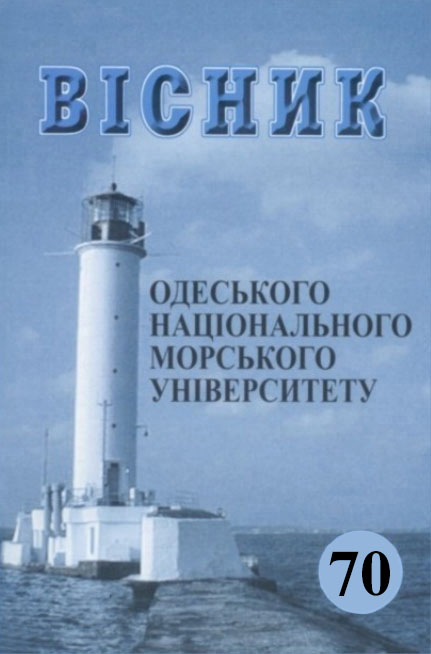Selection of the maneuver to return the ship to the program trajectory of movement without coordination with the purpose
Main Article Content
Abstract
The article deals with one of the problems of preventing ships from closing, as one of the most important problems in the safety of ship navigation. In the process of computer simulation of the process of disengagement of ships, which are located on small distances of insecurity, it can be caused at the stage of turning ships on their program trajectories. The article obtained the condition for the safe exit of the ship to the program trajectory for the case when there is no coordination with the target. An expression is given for the relative angular velocity that occurs when ships turn, and a graphical dependence of the relative angular velocity on time is also presented
Article Details
How to Cite
Kalinichenko, T. (2023). Selection of the maneuver to return the ship to the program trajectory of movement without coordination with the purpose. Herald of the Odessa National Maritime University, (70), 47-57. https://doi.org/10.47049/2226-1893-2023-3-47-57
Section
Ensuring the safety of navigation
References
1. Tsimbal N.N. Flexible strategies of divergence of vessels / N.N. Tsimbal, I.A. Burmaka and E.E. Tyupikov. – Odessa: KP OGT. – 2007. – 424 p.
2. Pyatakov E.N. Cooperation of vessels at divergence for warning of collision / E.N. Pyatakov, R.Y. Buzhbeckij, I.A. Burmaka, A.Y. Bulgakov – Kherson: Grin D.S. – 2015. – 312 p.
3. Vagushchenko L.L. Divergence with vessels by displacement on the parallel line of way / L.L. Vagushchenko. – Odessa: Feniks. – 2013. – 180 p.
4. Pyatakov E.N. Estimation of efficiency of pair strategies of going away vessels / E.N. Pyatakov, S.I. Zaichko // Sudovozhdenie. – 2008. – № 15. – p. 166-171.
5. Kulakov М. Choice of optimum speeds of vessels at the external their process control of divergence / М. Kulakov // Automation of ship hardwires. – 2017. – № 23. – P. 51-57.
6. Statheros Thomas. Autonomous ship collision avoidance navigation concepts, technologies and techniques / Statheros Thomas, Howells Gareth, McDonald-Maier Klaus // J. Navig. 2008. – Vol. 61. – № 1. – P. 129-142.
7. Бурмака И.А. Маневр последовательного расхождения с двумя целями изменением курса и пассивным торможением / И.А. Бурмака, Э.Н. Пя- таков. // East European Science Journal. № 5 (33). 2018. – Part 1. – С. 19-24.
8. Volkov A. Apprisal of the Coordinability of the Vessels for Collision Avoidance Maneuvers by Course Alternation / A. Volkov, E. Pyatarov & A. Yakushev // Activites in Navigation. – Adam Weintrit. – 2015. – P. 195-200.
9. Kao Sheng-Long. A fuzzy logic method for collision avoidance in vessel traffic service / Kao Sheng-Long, Lee Kuo-Tien, Chang Ki-Yin, Ко Min-Der // J. Navig. 2007. – Vol 60. – № 1. – p. 17-31.
10. Imazu H. Evaluation Method of Collision Risk by Using True Motion / H. Imazu // TransNav, the International Journal on Marine Navigation and Safety of Sea Transportation. 2017. – Vol. 11. – № 1. – P. 65-70.
2. Pyatakov E.N. Cooperation of vessels at divergence for warning of collision / E.N. Pyatakov, R.Y. Buzhbeckij, I.A. Burmaka, A.Y. Bulgakov – Kherson: Grin D.S. – 2015. – 312 p.
3. Vagushchenko L.L. Divergence with vessels by displacement on the parallel line of way / L.L. Vagushchenko. – Odessa: Feniks. – 2013. – 180 p.
4. Pyatakov E.N. Estimation of efficiency of pair strategies of going away vessels / E.N. Pyatakov, S.I. Zaichko // Sudovozhdenie. – 2008. – № 15. – p. 166-171.
5. Kulakov М. Choice of optimum speeds of vessels at the external their process control of divergence / М. Kulakov // Automation of ship hardwires. – 2017. – № 23. – P. 51-57.
6. Statheros Thomas. Autonomous ship collision avoidance navigation concepts, technologies and techniques / Statheros Thomas, Howells Gareth, McDonald-Maier Klaus // J. Navig. 2008. – Vol. 61. – № 1. – P. 129-142.
7. Бурмака И.А. Маневр последовательного расхождения с двумя целями изменением курса и пассивным торможением / И.А. Бурмака, Э.Н. Пя- таков. // East European Science Journal. № 5 (33). 2018. – Part 1. – С. 19-24.
8. Volkov A. Apprisal of the Coordinability of the Vessels for Collision Avoidance Maneuvers by Course Alternation / A. Volkov, E. Pyatarov & A. Yakushev // Activites in Navigation. – Adam Weintrit. – 2015. – P. 195-200.
9. Kao Sheng-Long. A fuzzy logic method for collision avoidance in vessel traffic service / Kao Sheng-Long, Lee Kuo-Tien, Chang Ki-Yin, Ко Min-Der // J. Navig. 2007. – Vol 60. – № 1. – p. 17-31.
10. Imazu H. Evaluation Method of Collision Risk by Using True Motion / H. Imazu // TransNav, the International Journal on Marine Navigation and Safety of Sea Transportation. 2017. – Vol. 11. – № 1. – P. 65-70.
